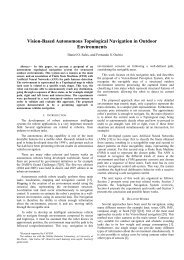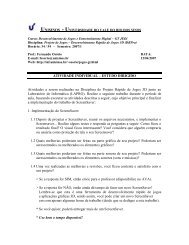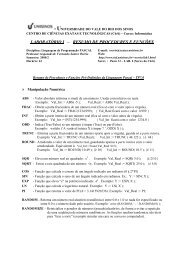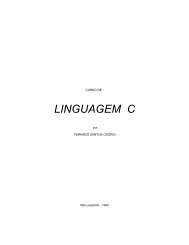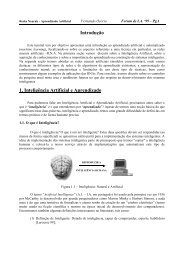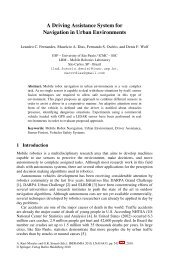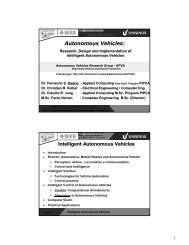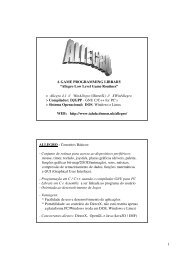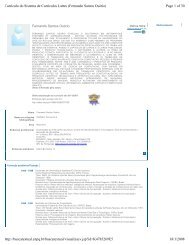Controle Inteligente do Caminhar de Robôs Móveis Simulados
Controle Inteligente do Caminhar de Robôs Móveis Simulados
Controle Inteligente do Caminhar de Robôs Móveis Simulados
You also want an ePaper? Increase the reach of your titles
YUMPU automatically turns print PDFs into web optimized ePapers that Google loves.
9Figura 6. Robôs treina<strong>do</strong>s para transpor <strong>de</strong>sníveis e escadas<strong>de</strong> uma re<strong>de</strong> neural) através <strong>de</strong> robôs simula<strong>do</strong>s em um ambiente virtual realista.Além disso, o protótipo <strong>do</strong> mo<strong>de</strong>lo proposto permite a evolução da morfologia <strong>do</strong>robô em conjunto com os parâmetros <strong>de</strong> controle. Os resulta<strong>do</strong>s obti<strong>do</strong>s <strong>de</strong>monstramque: (i) as re<strong>de</strong>s neurais são bastante ecientes no controle das juntas<strong>do</strong> robô; (ii) o uso <strong>de</strong> algoritmos genéticos para a evolução <strong>do</strong>s pesos sinápticossurge como uma alternativa bastante atrativa <strong>de</strong> se resolver o problema da falta<strong>de</strong> informações locais para o cálculo <strong>do</strong> gradiente; (iii) a evolução da morfologiapermite que sejam <strong>de</strong>scobertos mo<strong>de</strong>los <strong>de</strong> robôs bastante ecientes.Agra<strong>de</strong>cimentosAgra<strong>de</strong>cemos ao apoio da CAPES e <strong>do</strong> CNPq a este traballho.Referências1. Heinen, M.R.: <strong>Controle</strong> inteligente <strong>do</strong> caminhar <strong>de</strong> robôs móveis simula<strong>do</strong>s.Dissertação <strong>de</strong> mestra<strong>do</strong>, Universida<strong>de</strong> <strong>do</strong> Vale <strong>do</strong> Rio <strong>do</strong>s Sinos (UNISI-NOS), São Leopol<strong>do</strong>, RS, Brasil (2007) Data <strong>de</strong> Conclusão: 20/02/2007. URL:http://bdtd.unisinos.br/t<strong>de</strong>_busca/arquivo.php?codArquivo=380.2. Knight, R., Nehmzow, U.: Walking robots - a survey and a research proposal.Technical Report CSM-375, Univ. Essex, Essex, UK (2002)3. Bekey, G.A.: Autonomous Robots: From Biological Inspiration to Implementationand Control. MIT Press, Cambridge, MA (2005)4. Pfeifer, R., Scheier, C.: Un<strong>de</strong>rstanding Intelligence. MIT Press, Cambridge, MA(1999)5. Chernova, S., Veloso, M.: An evolutionary approach to gait learning for four-leggedrobots. In: Proc. IEEE/RSJ Int. Conf. Intelligent Robots and Systems (IROS),Sendai, Japan (2004)6. Mitchell, T.: Machine Learning. McGrall-Hill, New York (1997)7. Heinen, M.R., Osório, F.S.: Applying genetic algorithms to control gait of physicallybased simulated robots. In: Proc. IEEE Congr. Evolutionary Computation(CEC), Vancouver, Canada (2006)8. Heinen, M.R., Osório, F.S.: Applying genetic algorithms to control gait of simulatedrobots. In: Proc. IEEE Electronics, Robotics and Automotive Mechanics Conf.(CERMA) 2007, Cuernavaca, Morelos, Mexico (2007) 5005059. Heinen, M.R., Osório, F.S.: Gait control generation for physically based simulatedrobots using genetic algorithms. In: Proc. Int. Joint Conf. 2006, 10thIbero-American Conference on AI (IBERAMIA), 18th Brazilian Symposium onAI (SBIA). LNCS, Ribeirão Preto - SP, Brazil, Springer-Verlag (2006)



